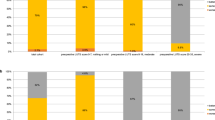Abstract
The purpose of this study was to determine the incidence of patient-self reported post prostatectomy incontinence, impotence, bladder neck contracture or stricture, better, same or worse quality of life and willingness for same treatment again in a large group of radical prostatectomy (RP) patients and to determine if these morbidities are predictable with demographic, surgical or prostate cancer (PC) factors.
Methods: A patient self-reporting questionnaire was completed and returned by 374 out of 458 eligible (81.7%) RP patients from one center, 267 (72.2%) have been operated since 1990 and all of whom were a minimum six month postoperative (75%>1 y). Questionnaire results were independently analyzed by a third party and correlated to demographic, operative, and tumor factors in an ongoing comprehensive PC database.
Results: The patient self-reported incidence of post prostatectomy incontinence (any degree), impotence, and bladder neck contracture or stricture was 72.2, 87.4, and 25.9%, respectively. The reported rate of incontinence requiring protection was 39.0% and only 2.4% had persistent bladder neck contracture/stricture. Pathologic stage (continuous variable) was the only factor to significantly predict incontinence and no factor could predict impotence or bladder neck contracture/stricture in univariate analysis. No factor was predictive of morbidity by multivariate analysis. Despite incontinence and impotence significantly affecting QOL self-reporting (P=0.001, 0.001, respectively) and willingness to undergo RP again (P=0.001, 0.067, respectively), the majority of patients would choose surgery again.
Conclusions: Although radical prostatectomy morbidity is common and affects patient-reported overall QOL, most patients would choose the same treatment again. Demographic, preoperative, operative, and tumor factors did not reliably predict patient-reported morbidity in this series.
This is a preview of subscription content, access via your institution
Access options
Subscribe to this journal
Receive 4 print issues and online access
$259.00 per year
only $64.75 per issue
Buy this article
- Purchase on Springer Link
- Instant access to full article PDF
Prices may be subject to local taxes which are calculated during checkout
Similar content being viewed by others
Author information
Authors and Affiliations
Rights and permissions
About this article
Cite this article
Moul, J., Mooneyhan, R., Kao, TC. et al. Preoperative and operative factors to predict incontinence, impotence and stricture after radical prostatectomy. Prostate Cancer Prostatic Dis 1, 242–249 (1998). https://doi.org/10.1038/sj.pcan.4500248
Received:
Revised:
Accepted:
Published:
Issue Date:
DOI: https://doi.org/10.1038/sj.pcan.4500248
Keywords
This article is cited by
-
Recurrent urethrovesical anastomotic strictures following artificial urinary sphincter implantation: a case report
Journal of Medical Case Reports (2012)
-
Contemporary Incidence of Postprostatectomy Incontinence and Impact on Health-related Quality of Life
Current Bladder Dysfunction Reports (2010)
-
Long-term functional and oncological results after retroperitoneal laparoscopic prostatectomy according to a prospective evaluation of 550 patients
World Journal of Urology (2006)
-
Sildenafil: A 4-year update in the treatment of 20 million erectile dysfunction patients
Current Urology Reports (2003)



